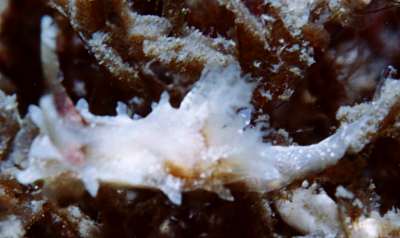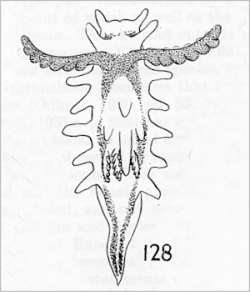Rediscovery of Okenia evelinae
January 28, 2004
From: Bill Rudman


PHOTOS:. Upper: Live animal from Lake Worth Lagoon, Florida, USA. Depth: 15 feet. January 2004. Approx 3/8 inch. Photo: Judy Townsend.
Lower: Okenia evelinae. Marcus, 1957 - Fig 128.
The photo of an Okenia from Florida in Linda Ianiello's message is almost certainly Okenia evelinae. The species is known only from the original description from Brazil, the description being based on 23 specimens, the largest being 8mm long alive. They were found on the arborescent bryozoan Amathia convoluta, and the colour was described as:
".. integument white and contains refractive granules on the back. The tissues of the inner organs are yellow, the liver dark yellow. The dorsal appendages, the gills and the borders of the foot are pure white. The rhinphores are violet, and the same colour occurs on the sides, the tail, and in small quantities on the back of full grown animals."
Marcus also describes 4 dorsal papillae in front of the gills, 2 median and 2 lateral, and a series of 5 or 6 "blunt peg-shaped appendages on each side" along the mantle edge. Although the dorsal papillae are not clear in Judy Townsend's photo, the other features of the external shape and colour, as described by Marcus, are. In this animal, the purple markings on the body, as described by Marcus, are replaced by a brownish colour, but as the purple on the rhinophores merges into brown, this is obviously a variable character in this species.
Clark (1984) considers O. evelinae to be a synonym of O. zoobotryon considering the colour differences [purple rhinophores] and size and number of radular rows to be unimportant and 'may be due to variations in diet and size'.
I find this a rather circular argument. Zoobotryon pellucida is the only food on which 'typical' O. zoobotryon has been found on. While it might be possible to suggest that specimens living on a different bryozoan, in this case Amathia, might have different colour and radular morphology, there is no evidence to support this theory in any other species. We normally assume that animals feeding on different organisms and showing different morphologies are different species, unless proven otherwise. One significant difference not discussed by Clark (1984) is the shape of the papillae around the mantle edge. In O. evelinae they are short and triangular, tapering to a rounded tip while in O. zoobotryon they have a thin stalk ending in a swollen rounded tip, described by Valdes & Ortea (1995) as like a 'chess pawn'.
Valdes & Ortea (1995) in the revision of some Atlantic species have followed Clark in considering O. evelinae to be a synonym of O. zoobotryon. The descriptions of O. zoobotryon by various authors (Clark,1984; Edmunds, M. & Just, H.,1985; Redfern. C., 2001; Smallwood, W. M., 1913; Valdes & Ortea,1995)clearly define that species. The animal in Linda Ianiello's message does not fit that description at all, but meets the original description of Okenia evelinae in all essential external features, and suggest that it is a good species, quite distinct from O. zoobotryon.
References:
• Clark, K. B. (1984) New records and synonymies of Bermuda opisthobranchs (Gastropoda). The Nautilus, 98(2): 85-97.
• Edmunds, M. & Just, H. (1985) Dorid, dendronotoid and arminid nudibranchiate Mollusca from Barbados. Journal of molluscan Studies, 51(1): 52-63.
• Marcus, Er. (1957) On Opisthobranchia from Brazil (2). Journal of the Linnean Society of London, Zoology, 43(292): 390-486.
• Redfern. C., (2001) Bahamian Seashells: a Thousand Species from Abaco, Bahamas. Bahamianseashells.com Inc: Boca Raton. 1-280.
• Smallwood, W.M. (1910). Notes on the Hydroids and Nudibranchs of Bermuda. Proc. Zool. Soc. London. 1: 137-145
• Smallwood, W. M. (1913) Polycerella zoobotryon (Smallwood). Proceedings of the American Academy of Arts & Sciences, 47(16): 609-630.
• Valdes, A. & Ortea, J. (1995) Revised taxonomy of some species of the genus Okenia Menke, 1830 (Mollusca: Nudibranchia) from the Atlantic Ocean, with the description of a new species. The Veliger, 38(3): 223-234.
Bill Rudman
Rudman, W.B., 2004 (Jan 28) Rediscovery of Okenia evelinae. [Message in] Sea Slug Forum. Australian Museum, Sydney. Available from http://www.seaslugforum.net/find/12043Related messages
-
Bryozoan of Okenia evelinae
From: Linda Ianniello, February 11, 2004 -
Food of Okenia evelinae
From: Bill Rudman, February 5, 2004 -
Okenia evelinae f rom Florida
From: Linda Ianniello, January 28, 2004
